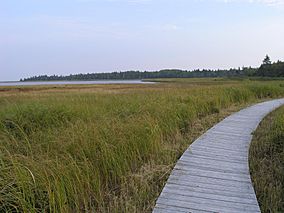Kouchibouguac National Park facts for kids
Quick facts for kids Kouchibouguac National ParkParc national de Kouchibouguac (French) |
|
|---|---|
|
IUCN Category II (National Park)
|
|

Boardwalk over a salt marsh
|
|
| Location | Kouchibouguac, New Brunswick, Canada |
| Area | 238 km2 (92 sq mi) |
| Established | 1969 |
| Visitors | 159,398 (in 2015-16) |
| Governing body | Parks Canada |
Kouchibouguac National Park is a beautiful natural area on the east coast of New Brunswick, Canada. It's a special place with many different landscapes. You'll find sandy barrier islands, tall sand dunes, calm lagoons, and salty salt marshes here. Thick forests also cover parts of the park.
This park is home to many amazing animals. These include seabirds like the endangered piping plover. It also has the second largest tern colony in North America. You might spot harbour seals and grey seals resting on the park's 25 kilometers of sand dunes. A very rare plant, the Gulf of St. Lawrence aster, also grows here. Sadly, storms in 2006 destroyed most of these asters.
Kouchibouguac National Park covers about 238 square kilometers. It's a great spot for fun activities like swimming, biking, and hiking. Recently, people have even seen the fisher marten in the park. This is exciting because they are rare in New Brunswick. The park offers many activities, from canoe trips to seal watching. You can also learn about the Mi'kmaq people. Kelly's Beach, a very popular spot, is also part of the park.
Contents
Park History and Creation
Kouchibouguac National Park was created in 1969. Its main goal was to protect sensitive sand dunes and bogs. At that time, park rules meant that all people living permanently in the area had to move out. Most of these residents were Acadians. Their ancestors had been forced to move from their homes long ago.
Parks Canada faced many challenges when trying to get land from the people. About 215 families, including over 1200 people, lived in seven communities. These communities were Claire-Fontaine, Fontaine, Rivière au Portage, Kouchibouguac, Guimond Village, Cap St-Louis, and Saint-Olivier. Government officials thought the residents were very poor. They believed moving would help them start new, better lives elsewhere. The government even offered courses to help people be more productive. Officials truly thought they were helping by asking people to leave.
Community Resistance and Changes
However, the residents did not want to leave their homes. They resisted the move and even shut down the park several times. One famous person was Jackie Vautour. His home was bulldozed in 1976. But he returned two years later and lived there until he passed away in 2021. Jackie Vautour's long fight made him a folk hero.
Today, the story of the former residents is told at the park's Visitor Centre. This permanent exhibit shares their experiences. Because of this resistance, Parks Canada changed its rules. Now, no one will ever be forced to leave their homes for a park again.
Park Name and Rivers
The park has a Mi'kmaq name, which is also the name of the Kouchibouguac River. In the Mi'kmaq language, the river's name means "river of the long tides." Many local Acadian residents did not like this name. They wanted a name that showed their own identity better. Many wanted the park to be called Claire-Fontaine, after one of the communities that was removed.
Other rivers that flow through the park include:
- Black River
- Kouchibouguacis River
- Saint-Louis River
- Portage River
Park in Media
The story of Kouchibouguac National Park has been featured in two big documentaries. It was also part of a short film in 2011 called National Parks Project. This film was directed by Jamie Travis. Its music was created by Casey Mecija, Don Kerr, and Ohad Benchetrit. There is also a website with 26 video portraits. These videos show the people who were removed from their land when the park was created.
Amazing Animals of Kouchibouguac
Kouchibouguac National Park is home to many different types of animals. You can find mammals, birds, and marine creatures here.
Mammals in the Park
Many mammals live on the land within the park. These include raccoons, bobcats, and lynx. You might also see moose and different kinds of bats. Other animals are timber wolfs, coyotes, and black bears. Smaller mammals like beavers, martens, and various shrews also live here. You can also find river otters, porcupines, and muskrats. Different types of mice, woodchucks, minks, striped skunks, and snowshoe hares complete the list.
Birds in the Park
The park is a great place for birdwatching. You can spot majestic bald eagles flying overhead. Many types of geese, woodpeckers, and three kinds of falcons live here. You'll also see various ducks, loons, and a wide range of owls. Different kinds of hawks are also common.
Marine Animals Offshore
The waters near the park are full of marine life. You can find a variety of seals swimming offshore. Dolphins and porpoises also visit these waters. And if you're lucky, you might even see different kinds of whales.
Images for kids
See also
 In Spanish: Parque nacional Kouchibouguac para niños
In Spanish: Parque nacional Kouchibouguac para niños




